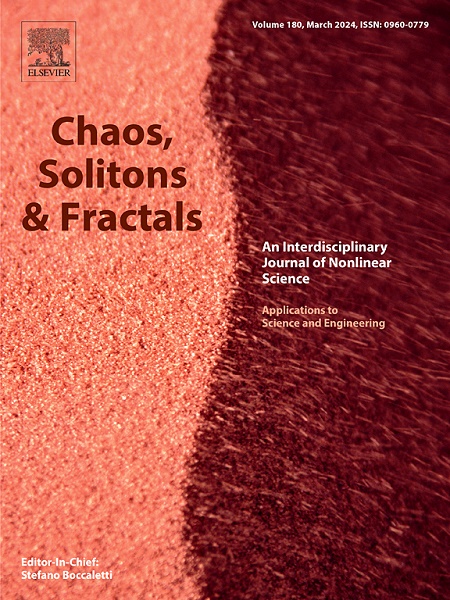Multifractal analysis of temperature in Europe: Climate change effect
IF 5.3
1区 数学
Q1 MATHEMATICS, INTERDISCIPLINARY APPLICATIONS
引用次数: 0
Abstract
We investigated multifractality of temporal series of daily mean air temperature anomalies over the entire European continent by applying the method Multifractal detrended fluctuation analysis (MFDFA) on high resolution E-OBSv26.0e dataset. The spatial resolution is 0.10 which corresponds to 120,866 grid cells, and the time span of daily temperature series is from 1961 to 2020, which permits to compare two climate periods (1961–1990 and 1991–2020) and evaluate the impact of climate change. For each grid cell and each of the two periods we calculated the multifractal spectrum which contains the information about specific properties of temperature series: persistence (described by the position of the maximum of the spectrum ), strength of multifractality (described by the spectrum width ) and the contribution of large/small fluctuations (described by the spectrum skew parameter We found that in both periods temperature series exhibit properties of a multifractal process, with persistent long-term correlations (and the dominance of scaling of small fluctuations (). The spatial distribution of multifractal parameters exhibits a distinct gradient during the first period. The parameter (persistence) increases from west to east and from south to north. In contrast, (strength of multifractality) decreases from south to north in regions outside Eastern Europe, whereas it increases from south to north within Eastern Europe. In the second period, the area with stronger multifractality (higher values) of temperature anomalies expanded significantly in Eastern Europe. The spatially averaged value and the range of the width W of the multifractal spectrum increased in the second period following the increase of the mean daily temperature. These results reveal the impact of climate change on multifractal properties of air temperature.
欧洲温度的多重分形分析:气候变化的影响
在高分辨率E-OBSv26.0e数据集上,应用多重分形去趋势波动分析(MFDFA)方法,研究了整个欧洲大陆日平均气温异常时间序列的多重分形特征。空间分辨率为0.10,对应120,866格元,日温度序列的时间跨度为1961 - 2020年,可以比较1961 - 1990年和1991-2020年两个气候期,并评估气候变化的影响。对于每一个网格单元和每一个周期,我们计算了多重分形谱fα,它包含了温度序列的特定性质信息:持续度(由光谱最大值α0的位置描述)、多重分形强度(由光谱宽度W描述)和大/小波动的贡献(由光谱偏度参数r描述)。我们发现,在两个时期,温度序列都表现出多重分形过程的特征,具有持续的长期相关性(α0>0.5)和小波动的标度优势(r>0)。在第一阶段,多重分形参数的空间分布呈现明显的梯度。α0(持续性)参数由西向东、由南向北逐渐增大。相比之下,W(多重分形的强度)在东欧以外的地区从南到北减少,而在东欧从南到北增加。第二阶段,温度异常多重分形较强(W值较高)的区域在东欧显著扩大。第二阶段多重分形谱的空间平均值和宽度W的变化幅度随着日平均气温的升高而增大。这些结果揭示了气候变化对气温多重分形特性的影响。
本文章由计算机程序翻译,如有差异,请以英文原文为准。
求助全文
约1分钟内获得全文
求助全文
来源期刊

Chaos Solitons & Fractals
物理-数学跨学科应用
CiteScore
13.20
自引率
10.30%
发文量
1087
审稿时长
9 months
期刊介绍:
Chaos, Solitons & Fractals strives to establish itself as a premier journal in the interdisciplinary realm of Nonlinear Science, Non-equilibrium, and Complex Phenomena. It welcomes submissions covering a broad spectrum of topics within this field, including dynamics, non-equilibrium processes in physics, chemistry, and geophysics, complex matter and networks, mathematical models, computational biology, applications to quantum and mesoscopic phenomena, fluctuations and random processes, self-organization, and social phenomena.
 求助内容:
求助内容: 应助结果提醒方式:
应助结果提醒方式:


